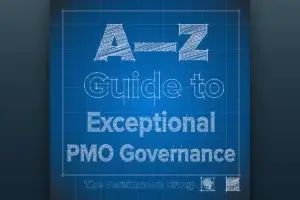Organizations striving for competitive advantage have recognized the importance of unlocking the full potential of their Project Management Office (PMO). However, traditional PMOs have often fallen short in measuring their impact on strategic goals. To address this issue, a new approach called the Value Delivery Office (VDO) has emerged. This transformational journey starts with abandoning the conventional PMO label and embracing a broader perspective. By shifting focus from tactical to strategic, VDOs pose critical questions that help define and measure success in ways that truly matter.
So, how do we measure the true value and success of our PMO?
1. You might want to stop calling it a PMO.
Did you know that a growing number of organizations are abandoning the term “PMO?” Instead, they call themselves Value Delivery Offices (VDOs). What’s in a name? First, VDOs typically encompass both traditional projects and agile workstreams. But beyond that, a VDO focuses on building a competitive advantage. VDOs care about whether you are better or worse than your competitors at executing your big ideas.
VDOs ask:
✓ How quickly and reliably can you execute your long-range strategic priorities?
✓ How quickly can you get valuable products to customers (or internal stakeholders?)
✓ How resilient is your organization when priorities must suddenly change?
✓ How adaptable are your teams when disruption occurs?
Traditional PMOs, on the other hand, are often overly focused on tactical measures of project or portfolio performance. PMOs often track measures like scope, schedule, and budget variances across the portfolio–but skimp on important questions like “Are we working on the right things?” or “How quickly can we respond when the strategy needs to shift?”
2. Decide what success looks like overall.
How would you know if you were better than your competitors at executing your big ideas? What would that look like? You don’t need to identify measures or quantifiable targets at this stage. Just paint a picture. If you’re stuck, start with these prompts:
If you were better than your competitors at executing your big ideas…
What would change about your strategic position?
What impact would you see on your customers?
How would your stakeholders react?
What would it feel like to work here?
3. Define specific, measurable indicators of success.
Next, translate your vision into specific, measurable indicators. Typical measures include speed to market, customer satisfaction, strategic alignment, adaptability, and waste:
Speed to Market: One key measure of value is how quickly you can bring a product or service to the market or an internal stakeholder. Do you outpace your competitors? Are you meeting the needs of your customers as they arise?
Customer Satisfaction: Another valuable measure is your customers’ satisfaction. This can be internal (your stakeholders) or external (your end-users). High satisfaction levels can demonstrate your projects’ effectiveness and adaptability to meet their needs.
Strategic Alignment: The alignment of your projects with your company’s strategic objectives is a crucial indicator of success. Are your projects directly contributing to achieving your company’s strategic goals?
Adaptability: This refers to how well your PMO can respond to changes in the business environment, whether that’s a shift in market trends, organizational strategy, or customer needs. When priorities need to change, how adaptable and resilient is your team in closing (or amending) one project and starting another? Is previous work scrapped, or does the team find a way to salvage or repurpose the work product?
Waste Reduction: This measure evaluates how well your PMO can eliminate inefficiencies and streamline processes. Less waste means more resources are directed toward value-creating activities, boosting your PMO’s value and success. This is where more traditional portfolio performance metrics like schedule and cost variance fit in.
4. Continuously review and adapt your measures.
Finally, keep in mind that measurement isn’t a one-time activity. It’s an ongoing process. The business world is continually changing, and so should your measures. Ensure you periodically review and update your success metrics to ensure they’re still relevant and valuable.
Remember…the true value of your PMO (or VDO!) isn’t just about how well you manage projects. It’s about how well you enable your organization to execute its strategy and deliver value.










